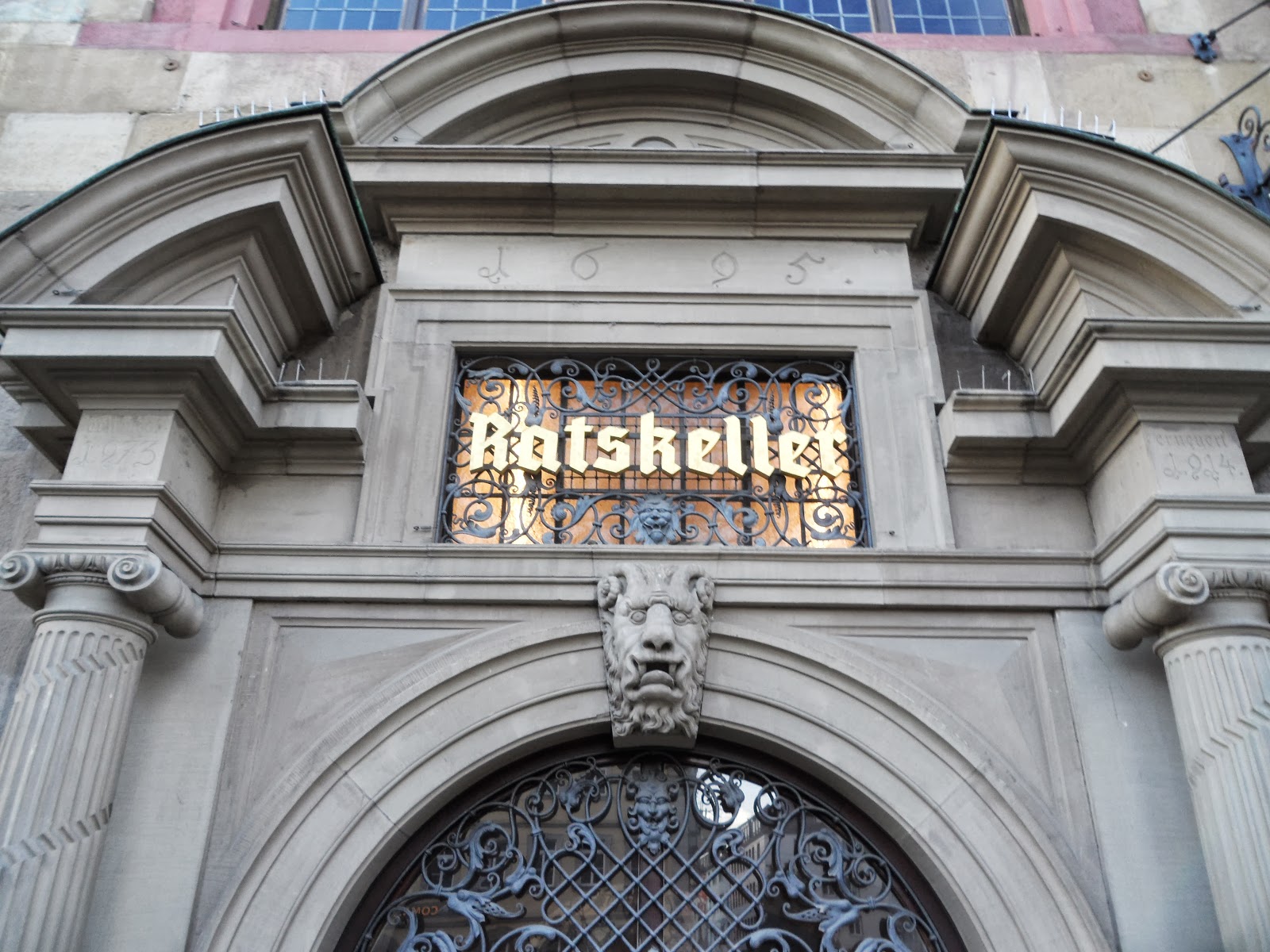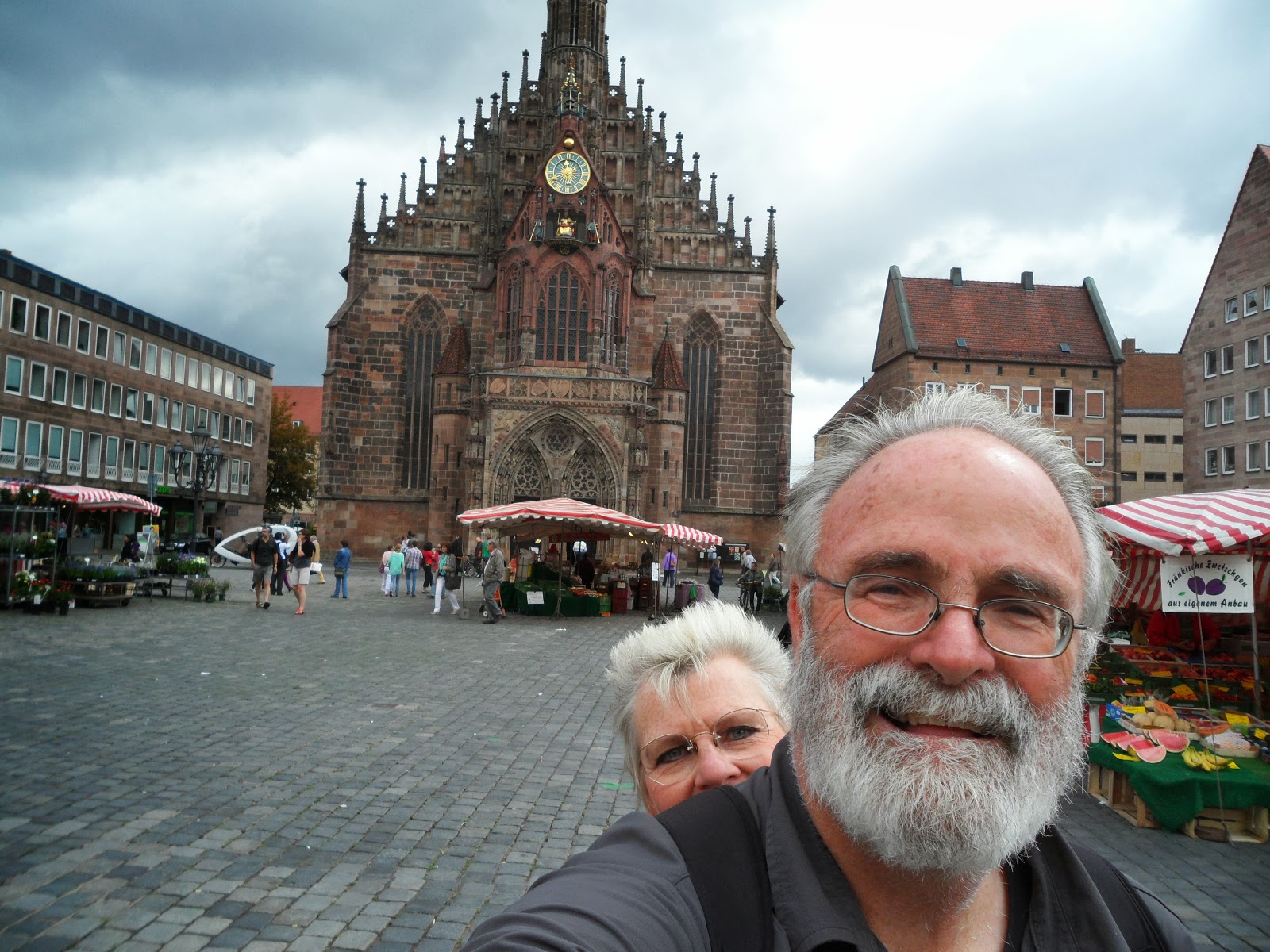We called a friend, Jacques, who works in Luxembourg, and he came and picked us up and took us to his house, where we spent the night. In the afternoon, we took a tour of Luxembourg City with Jacques, his wife Francoise and their two children. The pub to the left is the oldest in the city, dating back to the 700s.
This is the Grand Duke's official palace, although he no longer lives here.
This is just another street scene, with an interesting character.
The city is pretty hilly with big valleys in between the hills. It kind of reminds me of San Diego, like that. Here is one wall of the Luxembourg fortress looking out over a valley to another hill.
Here's a picture of the Jacques and Francoise along with their children and the top of Kathy's head.
Back to Germany
On Sunday morning we went to church with Mike and Jacques and their families, which was a real blessing. Luxembourg is a multilingual country so we sang worship songs in English, French, German, and (possibly) Luxembourgish. It was a neat time.
Right after the service, we walked over to the train station, and caught the train back into the city. Before we left the states, we purchased a 3-day German Rail pass. But, before we could start using it, we had to get out of Luxembourg and into Germany.
We paid 2 Euro each for a Luxembourg rail ticket which allowed us to travel all across Luxembourg from Esch (where Jacques lives) to Luxembourg City, and from there to Wasserbillig on the German border. However, to get a train ticket that crossed the border into Trier, it cost us 7.50 Euro each. In Luxembourg City we were able to validate our Rail Pass (even though we weren't yet in Germany), so when we got to Trier, we were able to move to a first-class compartment.
The trip from Trier to Koblenz took us until about 4:30 in the afternoon. When we got to Koblenz, we almost immediately found a direct train to Wurzburg, where we decided to spend our last three days. We arrived at our hotel, the Wurzberger Hof at 7:30, then walked across the street to the JulliusSpital for a really great meal. With all that, though, it was 11:30 before we got to bed.
On Monday, we woke up and decided to use Day 2 of our rail pass to visit Bamberg, a well preserved medieval town, and Nuremberg. Each is about an hour from Wurzburg and that would allow us to make a circular tour: Wurzburg->Bamberg->Nuremberg->Wurzburg.
Everything cooperated, except for the weather. It started out sprinkling lightly. We took our umbrellas and walked around Bamberg. Here's a view of the river from in front of the Rathaus.
Here's the Rathaus or city hall (the name seems so appropriate).
There were a lot of monuments and city is very quaint.
However, in the rain, it's really not much fun. And the rain kept coming down harder and harder. We'd duck into doorways when it got too strong. We visited the Cathedral.
As the rain increased, we decided to wait it out with lunch. Kathy had potato pancakes with applesauce (a Franconian dish), while I had what was described as "German Meatloaf", but what turned out to be two slices of something the consistency of baloney, but about a half-inch thick. Despite how it sounds, though, it was pretty good.
Here's what the dining room looked like.
By the time we finished lunch, the rain had still not let up, so we decided to head for Nuremberg to see if things looked better there.
The train from Bamberg to Nuremberg also takes about an hour. Once we got on the train, the rain stopped. All the way to Nuremberg, there was no rain. There were, however, very black dark clouds, like those you see in a documentary on tornadoes, that seemed to be following the train.
When we got off the train in Nuremberg, Kathy wanted to just catch the train back to Wurzburg, since the skies looked so threatening. I insisted we at least try walking around until it actually started raining.
We walked through the station, and by the time we got to the huge front doors, the skies let loose. The hundreds of people who had been milling around in front of the station crowded into the front entrance. The wind blew and bicycles were blown down. The cars trying to drive on the road in front of the station had to pull over onto the sidewalk. The rain was blowing sideways, and it looked like the films of a hurricane in Florida.
I thought for a few moments and decided that maybe Kathy had a point. We caught the next train back to Wurzburg. When we got there, the rain had stopped, but it still looked threatening. Nevertheless we decided to tour the town. Here's the King of Franconia's palace, called the Residenz.
And here's the statue of the King of Franconia looking in the other direction. You can see the skies clearing.
Wurzburg was bombed five days before WWII ended and almost every building was destroyed. Later, as at Nuremberg, they rebuilt the historic sites using the original materials. Here is the front of St. Kilian's Cathedral which wasn't restored until 1960.
Here is just a window treatment that I liked.
Inside the Cathedral, they have a theme that starts with the menorah in the back (representing the Old Testament) and progresses up to the risen Christ behind the altar.
Along the aisles they have full sized memorials to the bishops that ruled here. The one below is Prince-Bishop Rudolf von Scherenberg whose name means "scisors man". You can see the scissors on the coat of arms by his right hand.
This statue was carved by the famous sculptor, Tilman Riemenschneider in "late-Gothic realism" style which was considered quite avant-garde at the time. As you leave the church over the door is a depiction of the three Irish missionaries who came to Christianize the barbarian Wurzburgers in 686, and who were beheaded. Their skulls lie in a box behind the altar in the church.
After the Cathedral, we walked around some more. Kathy shopped for candy, but couldn't find exactly what she wanted.
The Marienkapelle was the competing church in town; the merchant's answer to the prince-bishop's cathedral. It has a nice last judgement over the door.
The Rathaus is right before the bridge coming into town...
...and underneath, the Ratskeller.
By this time, the sun was shining, and we were both pretty hungry.
We grabbed a table at the "old mill house" restaurant, right on the river. We sat outside on the lower balcony.
I had sausages and fried potatoes, while Kathy had a salad and mushroom soup.
Nuremberg Revisited
Our last full day, we decided to give Nuremberg one last try. We bought some cheese, butter and jam at a local supermarket, and ate them, with our coffee, at StarBack.
On the main market square, we took a picture in front of the Pfarrkirche Unsere Liebe Frau, or, the Frauenkirche.
We also looked at the Schoner Brunnen or "Beautiful Fountain", a gilded replica of the 14th century original.
On the southwestern side is a seamless golden ring. Local superstition says that if you turn it three times your wish will come true, so there is a line to do that. On the opposite side is a less obvious ring that is supposed to cause you to conceive.
The inside of the Cathedral had several really nice paintings and wood carvings.
At noon all of the tourists (us included) gather in front of the church to see the animated clockworks.
After the show, we visited the Rathaus...
...and then headed over to St. Sebalduskirche. I don't know who St. Sebardus is, but the church has a lot of interesting paintings.
In the church is St. Sebaldus wrought-iron tomb. Notice that he's being borne away by a pack of snails.
Up the street are several Albrecht-Durer (the famous Nuremberg renaissance artist) sites. Here is his statue.
Here is a giant bronze rabbit dedicated to Durer.
And here is the house where he had his studio.
This is just an interesting statue nearby.
We had lunch at one of Durer's favorite restaurants, the Goldenes Posthorn.
I had schnitzel and Kathy had soup, pretzels and spitzal egg noodles.
Finally, on the way home, we walked by the "marriage" sculpture, based on a verse by Hans Sachs, the medieval cobbler-poet. It shows six different interpretations of marriage.
Well, that's it. We're off to breakfast, and we'll see you all later today!



















































